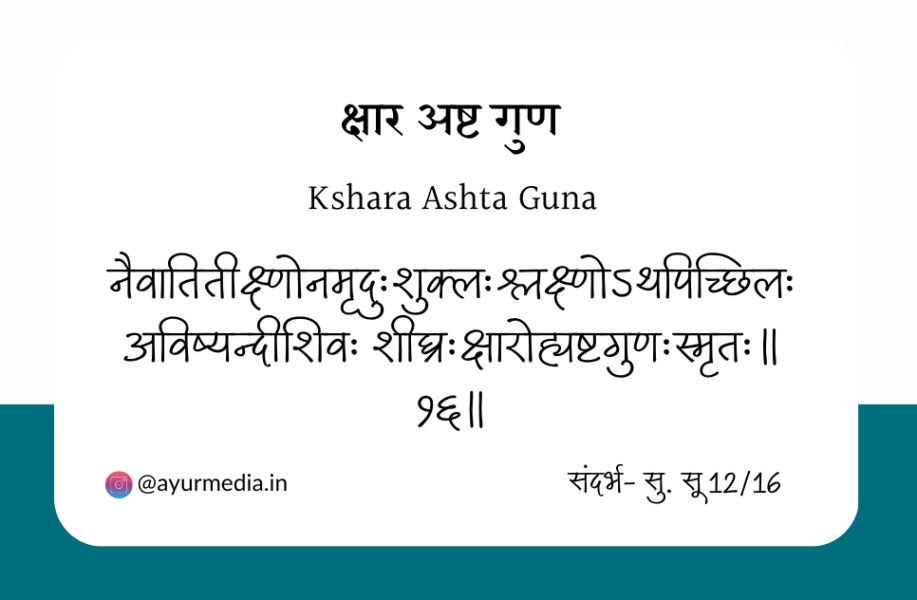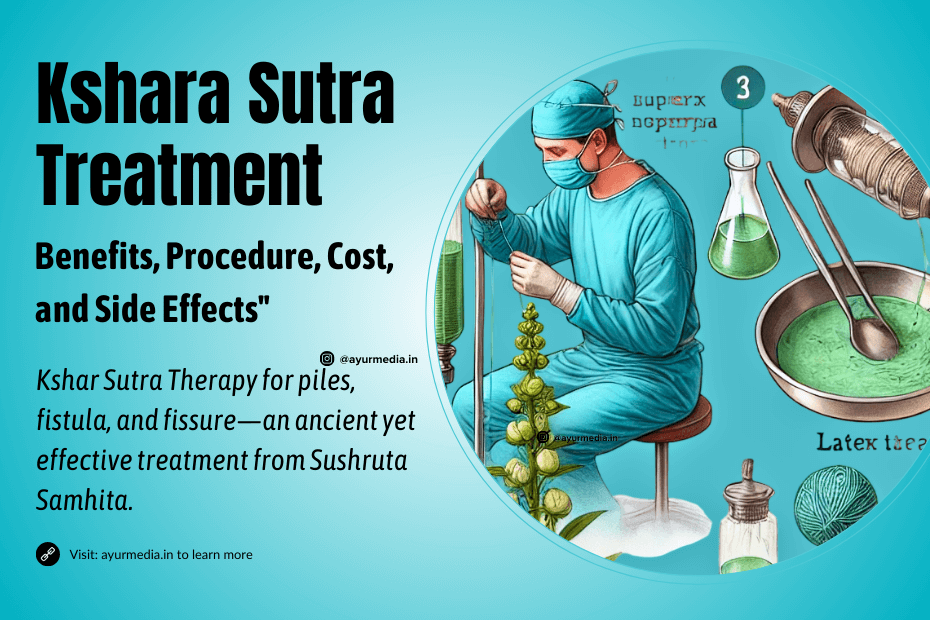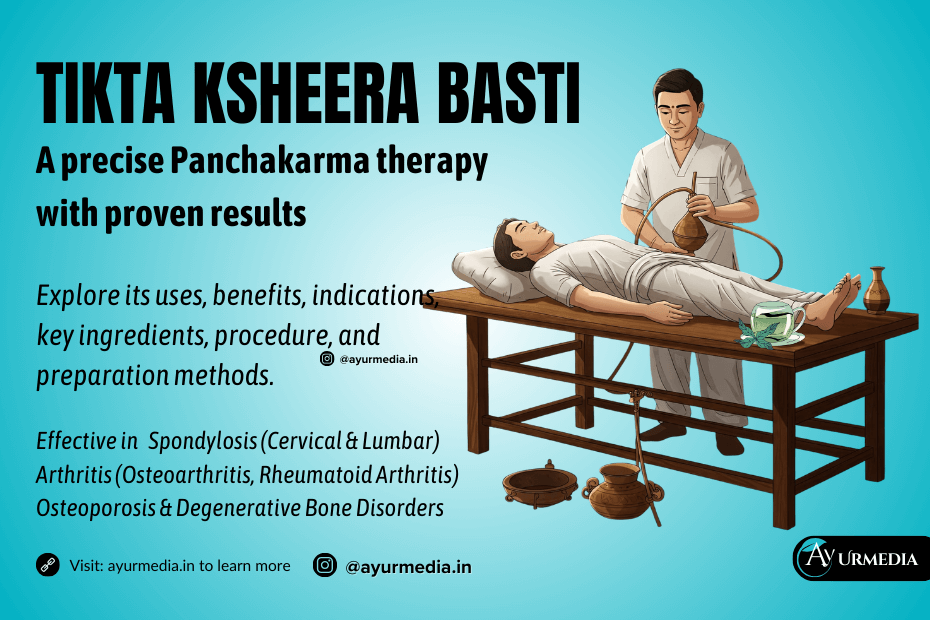Kshara Sutra Treatment, also known as Kshar sutra therapy or Kshara karma, is a minimally invasive parasurgical procedure described in Ayurveda. Its use is defined for conditions that need surgical management, such as Dushta Vrana (Chronic wounds), Nadivrana (Pilonadal sinus), Bhagandara (fistula-in-ano), Arsha (haemorrhoids), and Parikartika (anal fissure) or situations where conservative treatmennt have failed.
Kshara Karma is primarily described in Sushruta Samhita and has been validated through modern clinical research. Kshar Karma involves various methods utilizing Kshara preparation for both internal and external applications. Kshara Sutra therapy is a type of Kshara Karma that involves using a Kshara Sutra (medicated thread) for cauterization.
In this article, we will explore Kshar Sutra therapy, Kshara and its types, preparation method, treatment procedure, benefits, cost, and side effects.
What is Kshar Sutra?
Kshar Sutra is a medicated thread prepared through multiple coating of medicated herbs. It is prepared using herbal extracts that possess caustic and corrosive properties, known as Kshara (Alkalis). Ayurveda describes both internal and external uses of Kshara. For example, internal use involves tablets, Ksharavaleha, Kshara Ghrita, and procedures like Ksharabasti, while external use involves Kshara Taila, Kshara Sutra, Kshara Pichu, and Kshara Varti.
The primary ingredients in Kshara Sutra include:
- Apamarga (Achyranthes aspera) Kshara
- Snuhi (Euphorbia nerifolia) Latex
- Haridra (Curcuma longa) Powder
Kshar Sutra is highly effective in cutting, draining, and healing anorectal conditions. It is also effective for fistula-in-ano, hemorrhoids, and pilonidal sinus. It acts as a continuous chemical cauterization method, ensuring complete healing with minimal recurrence.
Kshar Sutra Treatment in Ayurveda
- In Sushruta Samhita Kshara is described as Superior to Shashtra (Surgical instruments) and Anushashtra (accessory instruments) highlighting its importance. Sushruta has described Kshara Sutra In the Chapter of Nadivrana (Infected Wounds).
- In Ayurveda Kshara is described as Agni Samaprabhava Dravya (having fire-like properties) due to its (sharp), Ushna (hot), and Dahana (cauterizing/burning) properties.
- In Charak Samhita Kshara Sutra is particularly mentioned in the treatment of Bhagandara (fistula-in-ano) in Shopha Chapter.
- The description of Kshara Sutra ingredients and preparation process is mentioned in Rastarangini.
Types of Kshara
According to Ayurveda, Kshara is mainly classified into two types based on the method of administration.
- Pratisaraniya Kshara or Bahirparimarjan (Intended for external use)
- Paniya Kshara or Antahparimarjana Bahirparimarjan (Intended for oral or internal application)
Kshara is further classified into three subtypes based on its potency or concentration.
- Mridu Kshara (Mild) – Used for soft tissue and mild disorders like Kushtha Roga (skin diseases) and early-stage haemorrhoids.
- Madhyama Kshara (Moderate) – Suitable for deeper and intermediate conditions like anal polyps.
- Tikshna Kshara (Strong) – Exhibits highly corrosive and caustic properties, primarily used in chronic, non-healing conditions like Bhagandara (fistula-in-ano), Arbuda (tumour), and Arsha (haemorrhoids), etc.
Kshara Guna (Qualities of Kshara)
In Ayurveda, Kshara is considered Tridoshaghna as it is made from multiple medicinal herbs, this helps pacify and balance the Tridosha.
| Rasa | Katu (Pungent) |
| Guna | Saumya (Soft and steady), Teekshna (Sharp), Agneya (Fire like) |
| Veerya | Ushna (Hot) |
| Effect on Dosha | Tridoshaghna (Pacifies Tridosha) |
Kshara Ashta Guna (8 Qualities of Kshara)
According to Sushruta an ideal Kshara should posses the following 8 Properties.

नैवातितीक्ष्णोनमृदुःशुक्लःश्लक्ष्णोऽथपिच्छिलः
अविष्यन्दीशिवः शीघ्रःक्षारोह्यष्टगुणःस्मृतः॥१६॥
naivātitīkṣṇonamṛduḥśuklaḥślakṣṇo’thapicchilaḥ
aviṣyandīśivaḥ śīghraḥkṣārohyaṣṭaguṇaḥsmṛtaḥ||16||
Su. Su 12/16
- Na Ati Tikshna (Not Too Strong or Sharp): Kshara should have controlled potency to prevent excessive tissue destruction or irritation.
- Na Ati Mrudu (Not Excessively Soft): The ideal Kshara is neither too soft nor too weak. A soft Kshara might not be effective in Kshedana (cutting harmful tissue), leading to incomplete healing.
- Na Ati Shukla (Not Excessively Cool or Hot): Kshara should be balanced in its thermal properties, so that it does not aggravate Tridosha excessively.
- Shlakshana (Smooth and Pleasant to Touch): It should have a smooth texture that allows easy application and minimal irritation.
- Pichhila (Slimy or Mucilaginous): The slimy (Pichhila) nature of Kshara helps in better adherence to the affected tissue as it remains in contact with the affected area for a longer time.
- Avishyandi (Non-Spreading or Immovable): Its action should remain localized to the affected area to prevents unwanted tissue destruction.
- Shiva or Saumya: Soft and steady
- Shighra (Rapid Action): Kshara should work effectively and quickly to promote fast wound healing and tissue regeneration.
Functions of Kshara and Kshara Sutra
According to Ayurveda Kshara posses the following properties.
- Chhedana (Excision or Cutting): Kshara has a strong excisional effect which helps in slow and controlled cutting through unwanted tissues and helps minimise surgical trauma to the surrounding area.
- Bhedana (Incision or Splitting Open) Its Bhedana property let Kshara Sutra to create a controlled incision or opening in abscesses, helping in their drainage and removal.
- Lekhana (Scraping or Debridement): Lekhana property helps remove unhealthy tissues, slough, and dead cells from the Dushta Vrana (Infected wounds) leading to fast healing and reducing recurrence rates.
- Dahana (Chemical Cauterization or Burning Effect): Its Dhana (cauterizing) properties helps in shrinking hemorrhoidal masses, destroying unhealthy tissue, and preventing bacterial infections.
- Vrana Shodhana and Ropana (Wound Cleansing and Healing): Kshara is prepared from many medicated herbs that possesses antiseptic and wound healing properties. The thread continuously releases herbal medicaments that cleanse the wound, prevents infection, and promote healthy tissue regeneration.
- Stambhana (Hemostatic or Bleeding Control): The Stambhana (hemostatic) action of Kshara helps minimise bleeding during and after the therapy thereby faster recovery and reducing the risk of complication.
Kshar Sutra Ingredients
The primary ingredients used in the preparation of Kshar Sutra include:
- Apamarga (Achyranthes aspera) Kshara – Its a Herbal Kshara (processed alkaline extract) with strong cauterizing, caustic and healing properties.
- Snuhi Ksheera (Euphorbia nerifolia) Latex – A natural Kshara (alkaline medium) with antimicrobial properties.
- Haridra (Curcuma longa) Powder – It has Anti-inflammatory and wound-healing properties.
Kshar Sutra Preparation Method
The preparation of Kshar Sutra involves 21 coatings of herbal extracts:
- First 11 coatings— A Barbour’s thread is coated with Snuhi Ksheera and allowed to dry. This process is repeated 11 times.
- Following eleven coatings, the Snuhi Ksheera is again applied and dried; the coated thread is then layered with Apamarga Kshara seven times.
- Final three layers – The last three coatings are applied using Haridra (Turmeric powder) for wound healing and antiseptic effects.
- After coating, The thread is dried at a controlled temperature in a hygienic chamber and stored in sterile conditions.
Kshara Sutra Indications
In Ayurveda, Kshara Sutra is indicated in the following conditions.
- Bhagandara (Fistula-in-ano)
- Arsha (Hemorrhoids/Piles)
- Nadi Vrana (Pilonidal sinus)
- Charmakeela (Warts, skin tags, polyps)
- Arbuda (tumours)
- Parikartika (anal fissure)
- Dushta Vrana (chronic wounds or non healing ulcers),
Kshar Sutra treatment for piles
Kshar Sutra surgery for piles is a minimally invasive procedure in which the medicated thread is tied at the base of the pile mass. This causes controlled necrosis, which leads to the detachment of the hemorrhoidal tissue within 5-7 days. The procedure is typically safe and painless and, with minimal bleeding and a low recurrence rate. It is usually performed as a day-care procedure, allowing patients to return to home same day.
A study comparing Kshara Sutra ligation and hemorrhoidectomy in Arsha (Piles) found Kshara Sutra more effective, with fewer complications and better outcomes. It proves to be a safe, cost-effective, and accessible treatment for 2nd, 3rd, and 4th-degree hemorrhoids1Gupta ML, Gupta SK, Bhuyan C. Comparative clinical evaluation of Kshara Sutra ligation and hemorrhoidectomy in Arsha (hemorrhoids). Ayu. 2011 Apr;32(2):225-9. doi: 10.4103/0974-8520.92591. PMID: 22408307; PMCID: PMC3296345..
Kshar Sutra treatment for fistula
Kshara Sutra is a treatment that is highly effective for complex and recurrent fistulas. Teekshana Pratisarneeya Kshara is used for this. The Kshar Sutra is inserted through the fistula tract that allow gradual cutting, drainage, and healing over a period of 4-6 weeks, preventing recurrence.
Several studies have demonstrated the efficacy of Kshar Sutra in treating anal fistula, with high success rates and minimal recurrence.
A Clinical trial was conducted to compare Kshara Sutra treatment with conventional surgery for fistula-in-ano. The findings revealed that while healing took longer with Kshara Sutra but the recurrence rate was significantly lower (4% vs. 11%). The study concluded that Kshara Sutra offers a better long-term outcome than surgery 2Multicentric randomized controlled clinical trial of Kshaarasootra (Ayurvedic medicated thread) in the management of fistula-in-ano. Indian Council of Medical Research. Indian J Med Res. 1991 Jun;94:177-85. PMID: 1937599..
A prospective study on Kshara Sutra therapy for Bhagandara (Fistula in Ano) showed its efficacy as a minimally invasive treatment with a low recurrence rate (5.88%)3Panigrahi, Hemanta Kumar1; Rani, Rakesh2; Padhi, M.M.3; Lavekar, G.S.4. Clinical Evaluation of Kshara sutra Therapy in the management of Bhagandara (Fistula- in-Ano)- A prospective study. Ancient Science of Life 28(3):p 29-35, Jan–Mar 2009..
A case report shows successful treatment of Anal fistula by Kshara Sutra with no recurrence4Ramesh PB. Anal fistula with foot extension-Treated by kshara sutra (medicated seton) therapy: A rare case report. Int J Surg Case Rep. 2013;4(7):573-6. doi: 10.1016/j.ijscr.2013.04.004. Epub 2013 Apr 17. PMID: 23702360; PMCID: PMC3679440..
Kshar Sutra for Fissure
Kshar Sutra is an effective treatment for chronic fissures. It aids in reducing fibrotic tissues, promoting the healing of ulcers, and preventing infections. It is recommended to use Kshara Sutra with sitz baths and appropriate medications.
Kshar Sutra for pilonidal sinus
Kshara Sutra treatment pilonidal sinus (Nadivrana) often done as a day cere procedure. Under local anesthesia, Kshar Sutra is carefully inserted through the sinus tract using a probe under local anesthesia. The thread continuously delivers herbal alkaline drugs, destroy unhealthy tissue through its cauterizing effect and healing occurs by granulation. The Kshara Sutra is replaced on weekly basis until the sinus is fully healed.
A case report shows successful treatment of recurrent pilonidal sinus using Kshara Sutra in a patient previously treated with Z-plasty but experienced a recurrence within three years. With Kshara Sutra therapy, the sinus tract was completely healed within four weeks with no recurrence.5Dwivedi AP. Management of pilonidal sinus by Kshar Sutra, a minimally invasive treatment. Int J Ayurveda Res. 2010 Apr;1(2):122-3. doi: 10.4103/0974-7788.64408. PMID: 20814527; PMCID: PMC2924975., tumours (Arbuda) and excision of skin tags.
Kshar Sutra Procedure
The Kshar Sutra is a minimally invasive procedure typically performed in an outpatient setting, allowing the patient to go home the same day.
- Pre-procedure Preparation involves a thorough patient evaluation, including an assessment of Prakriti (body constitution) and Vikriti (disease severity), then the diagnosis is made using clinical examination and proctoscopy.
- For bowel preparation, mild laxatives are provided. The procedure may involve administering local anesthesia or mild sedation.
- During the treatment, a Kshar Sutra is carefully inserted into the affected area. This thread is inserted through the fistula tract or hemorrhoidal mass using probes or a seton technique and a sterile dressing is applied to the area.
- The Kshara Sutra is left in place for a specific period, and typically replaced on weekly basis until the desired healing is achieved. However, when treating piles, the Kshar Sutra does not require weekly replacement.
- The Kshar Sutra gradually cuts, drains, and heals the affected tissue.
- New healthy tissue is formed over time, and recurrence rates are significantly lower than in conventional surgery.
Post procedure care includes application of Jatyadi Taila, Haridra Churna, Sitz bath and Ayurvedic Analgesics such as Guggulu.
Kshar Sutra treatment recovery time
The recovery time after Kshar Sutra treatment varies depending on the individual and the severity of the condition being treated. In general, patients can expect some discomfort and mild bleeding for a few days after the procedure. Complete healing may take several weeks. However, Patients can resume normal activities within 48 hours, but heavy lifting should be avoided for at least a week.
- Piles: 1-2 weeks
- Fistula-in-Ano: 4-6 weeks
- Anal Fissure: 2-4 weeks
Benefits of Kshar Sutra Therapy
- Minimally invasive – No major surgical incisions are required.
- High success rate – Effective in complex fistula cases resistant to modern surgical interventions.
- Reduced recurrence – Studies show Kshar Sutra has a recurrence rate below 10% compared to modern surgery (>30%).
- Faster recovery – Healing occurs naturally without excessive tissue damage.
- No hospitalization is required. It is performed as an outpatient procedure.
Kshar Sutra treatment cost
The cost of Kshar Sutra treatment varies depending on the clinic, the location, and the severity of the condition. It is generally cheaper than conventional surgical procedures. The procedure can range anywhere between INR 2,000 – 15,000 per session.
Kshar Sutra Side Effects
Although Kshar Sutra is a safe procedure, some potential Kshara Karma side effects include:
- Kshar Sutra therapy is associated with various side effects and precautions. Among these are some temporary discomfort and pain. These mild side effects are manageable using Ayurvedic pain relief herbs. In some cases, bleeding is a temporary side effect, but it usually ceases after a few hours.
- Another side effect is a burning sensation that stems from the cauterizing effects of Kshara. This is also often temporary. However, for some individuals, wound healing may be delayed. This can sometimes be alleviated by post-procedure care with Jatyadi Taila.
- In addition, the procedure poses an infection risk if neglected. If wound care is neglected in diabetic patients, it can lead to delayed healing. However, these risks can be avoided with proper post-procedural care.
- In conclusion, Kshar Sutra therapy has a few side effects, but most are temporary and manageable with appropriate wound care.
Conclusion
Kshar Sutra treatment is an Ayurvedic therapy that has been tested and proven for a long time. It provides a practical, minimally invasive and cost effective treatment for anorectal disorders, with high success rates and minimal recurrence. The high success rates have led many practitioners and patients to see Kshar Sutra treatment as a preferred method of treating these conditions.
References
- 1Gupta ML, Gupta SK, Bhuyan C. Comparative clinical evaluation of Kshara Sutra ligation and hemorrhoidectomy in Arsha (hemorrhoids). Ayu. 2011 Apr;32(2):225-9. doi: 10.4103/0974-8520.92591. PMID: 22408307; PMCID: PMC3296345.
- 2Multicentric randomized controlled clinical trial of Kshaarasootra (Ayurvedic medicated thread) in the management of fistula-in-ano. Indian Council of Medical Research. Indian J Med Res. 1991 Jun;94:177-85. PMID: 1937599.
- 3Panigrahi, Hemanta Kumar1; Rani, Rakesh2; Padhi, M.M.3; Lavekar, G.S.4. Clinical Evaluation of Kshara sutra Therapy in the management of Bhagandara (Fistula- in-Ano)- A prospective study. Ancient Science of Life 28(3):p 29-35, Jan–Mar 2009.
- 4Ramesh PB. Anal fistula with foot extension-Treated by kshara sutra (medicated seton) therapy: A rare case report. Int J Surg Case Rep. 2013;4(7):573-6. doi: 10.1016/j.ijscr.2013.04.004. Epub 2013 Apr 17. PMID: 23702360; PMCID: PMC3679440.
- 5Dwivedi AP. Management of pilonidal sinus by Kshar Sutra, a minimally invasive treatment. Int J Ayurveda Res. 2010 Apr;1(2):122-3. doi: 10.4103/0974-7788.64408. PMID: 20814527; PMCID: PMC2924975.



